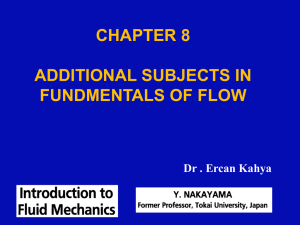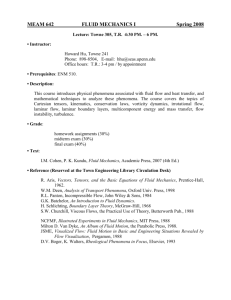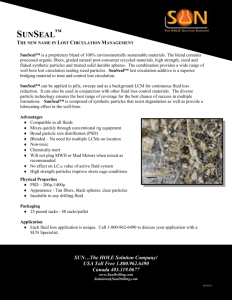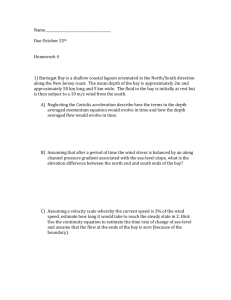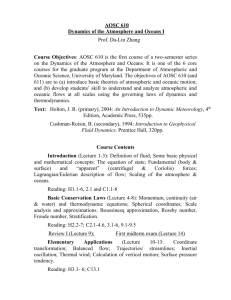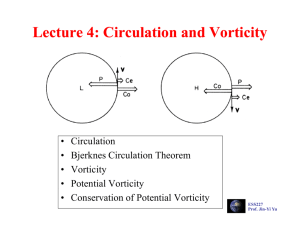Chapter III
advertisement
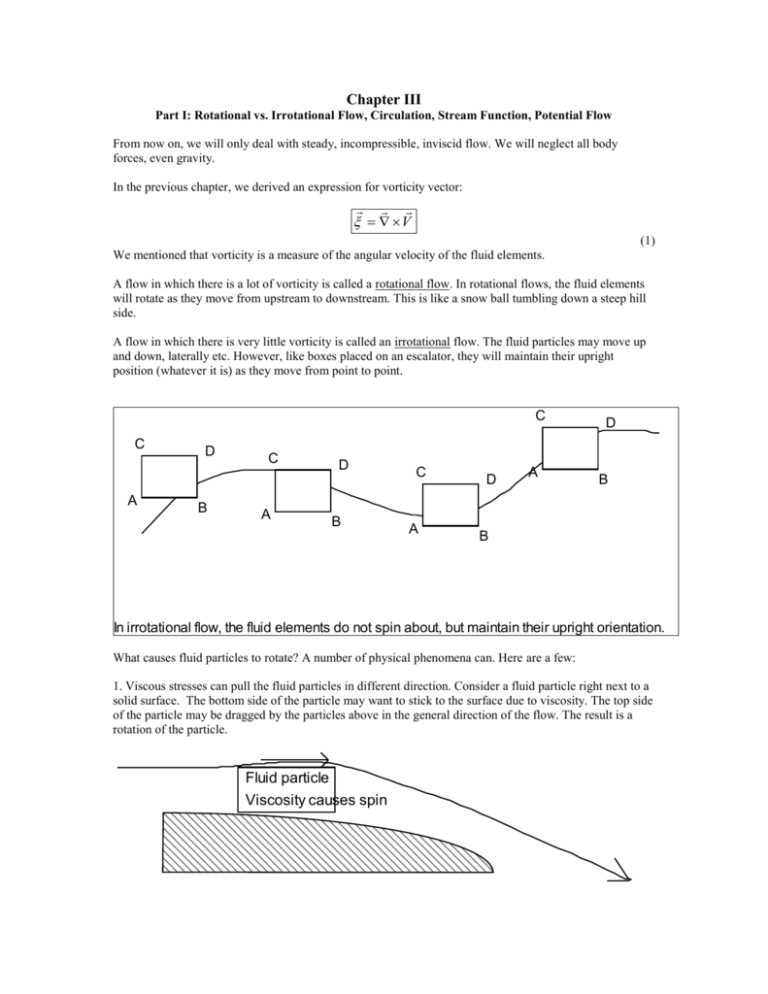
Chapter III Part I: Rotational vs. Irrotational Flow, Circulation, Stream Function, Potential Flow From now on, we will only deal with steady, incompressible, inviscid flow. We will neglect all body forces, even gravity. In the previous chapter, we derived an expression for vorticity vector: V (1) We mentioned that vorticity is a measure of the angular velocity of the fluid elements. A flow in which there is a lot of vorticity is called a rotational flow. In rotational flows, the fluid elements will rotate as they move from upstream to downstream. This is like a snow ball tumbling down a steep hill side. A flow in which there is very little vorticity is called an irrotational flow. The fluid particles may move up and down, laterally etc. However, like boxes placed on an escalator, they will maintain their upright position (whatever it is) as they move from point to point. C C A D B C A D B C A D A D B B In irrotational flow, the fluid elements do not spin about, but maintain their upright orientation. What causes fluid particles to rotate? A number of physical phenomena can. Here are a few: 1. Viscous stresses can pull the fluid particles in different direction. Consider a fluid particle right next to a solid surface. The bottom side of the particle may want to stick to the surface due to viscosity. The top side of the particle may be dragged by the particles above in the general direction of the flow. The result is a rotation of the particle. Fluid particle Viscosity causes spin Thus, boundary layers and viscous regions are rotational, and filled with vorticity. 2. Velocity differences at the edge of a jet can cause the top part of a fluid particle to move faster than the lower part, or vice versa. Result: Rotation. 3. Shock waves can slow down the flow. The strength of shock waves depends on the angle they make with the flow. There is usually a curved "bow shock" ahead of a blunt body. Even though the fluid particles ahead of the shock may be uniform, different fluid particles may impact the shock at different angles, and slowed down differently behind the shock wave. Result: rotation. 4. Non-uniform body forces (example, forces exerted by a spinning propeller on air particles) can cause different fluid particles to be accelerated differently, causing a non-uniform velocity field. Result: Rotation. Although most flows encountered in nature are rotational, if we stay away from viscous regions (boundary .layers), curved shock waves or non-uniform body forces, in all other regions the flow may be assumed to be irrotational. Assuming the flow to be irrotational greatly simplifies the mathematics, and the eventual solution of the flow on the computer. We will be invoking the irrotational flow assumption soon. Circulation: Consider a closed curve C in space. It is made of tiny straight line segments 'ds' each which may be thought of as a short vector. Then circulation over this contour C is defined as: V ds C (2) There is a theorem called Stokes Theorem which states that the circulation is related to the vorticity vectors crossing the surface A enclosed by the closed curve C as follows: V ds dA C S (3) The area A may be assumed to be made of several infinitesimal elements dA. The vector dA has the magnitude of the area dA, and is directed normal to dA. Stokes theorem says that if there is circulation, then there is vorticity, and vice versa. There will be no circulation over a contour C if the area captured by that contour does not contain any vorticity. Closed contour C Area A Streamline Body Streamline What happens if the contour C encloses the body? Then, since the body has a boundary layer, and the boundary layer contains vorticity, the circulation over any contour that encloses the body will usually be nonzero. The exception is a symmetric body (e.g. symmetric airfoil) which contains clockwise vorticity on one side, say the upper side boundary layer and counterclockwise vorticity on the lower side. Potential Flow: A irrotational flow (that is, a flow in which vorticity is zero) is also called a potential flow. This is because we can define a function called the velocity potential such that V Or , u x v y w z (4) If u, v and w are defined as derivatives of as shown, then vorticity in that flow is zero. This is because i V x x j y y k 2 2 i z y z z y z 2 2 2 2 j k xy yx 0 z x x z (5) If we use equation (4) in continuity equation V 0 Or , 2 2 2 i j k i j k 0 x z x x z x 2 y 2 z 2 x (6) Or, 2 0 (7) The operator is called the Laplacian operator. It is simply three second derivatives added together as shown below: 2 2 2 2 2 x 2 y 2 z 2 (8) Equation (7) is called Laplace's equation for the velocity potential . Why did we introduce a new variable called ? It is because we would rather solve a single linear PDE for (given by equation 7) than solve 4 nonlinear PDEs - conservation of mass, u- v-, w-momentum etc. If we can somehow solve equation (7), we can find u, v and w from equation (4). Finally, we can find p from the Bernoulli equation. We will spend much of our remaining time in this course solving equations (7), (4) and the Bernoulli equation. This simple equation may be used to model flow over airfoils, wings, bodies etc. It is truely useful. Of course, it works only for inviscid, incompressible, irrotational flows. It can not be used in regions of large vorticity, e.g. boundary layers. Stream Function: A less useful new variable is called stream function . It exists only in 2-D flows, or axisymmetric flows (e.g. flow around a body of revolution such as a sphere or a bullet). The stream function is defined as: y v x u (9) We define u and v this way to automatically satisfy the continuity equation for 2-D incompressible flows. u v 0 x y (10) For 2-D flows we only need to worry about the z- component of vorticity given by v u . You may x y recall that we derived this component by considering the angular velocity of a fluid element in a previous hand-out titled "Pathlines, Streamlines, Vorticity and Bernoulli's Equation". In irrotational flow, vorticity is zero. Setting v u to zero, and using the definitions given in equation (9) we get: x y 2 0 (11) Equation (11) is Laplace's equation for stream function. It is linear, and easy enough to solve. After we somehow solve for we can get u and v from equation (9). We can finally compute p from Bernoulli's equation. Equation of a Streamline: Recall that a streamline is defined as: dx dy u v Or , udy vdx 0 (12) Use the definitions of u and v from equation (9). Then equation (12) becomes: dy dx 0 y x Or , d 0 (13) Equation 913) implies that is constant along a streamline. We have thus two ways of solving 2-D inviscid irrotational flows (potential flows, for short)- solve for or solve for . Both require solving the Laplace's equation. We have only a single way of solving 3-D inviscid, irrotational flow (potential flows, for short). Solve for . The stream function is not defined in 3-D flows.
